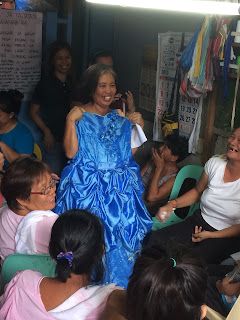Yes, both of these places are in Manila, but they have very little in common. This is the tale of two cities.
Generally, we believe that we are all equal. We cringe at
the sight of any form of discrimination and even protest when our own rights
are violated. However, is equality just a concept in today’s world? Each
example of social and economic inequality reminds us of George Orwell’s
statement that some people “are more equal than others” (I hope you’re familiar
with Animal Farm). One of the first things they teach us in Economics is that
limited resources are matched with unlimited wants. The sad reality of this is
that the majority is forced to live in a state of desolation so that the rich
can satisfy their unlimited wants.
Day two introduced us to two sides of the same city with the
help of our dear friends at Habitat for Humanity, an international NGO
dedicated to providing housing for the world’s poor. It is their vision to have
“a world where everyone has a decent place to live.” One of Habitat’s thriving
operations is housing microfinance. Although they do not provide microfinance
services on their own, they develop partnerships with microfinance institutions
such as Kasagana-ka Development Center Inc, which provides microloans, savings,
insurance and education for the urban poor.
The day’s activities began with a brief overview of
Kasagana-ka’s business objectives and operations.
You may read about poor
communities in books, see them in the news, or discuss them with colleagues,
but the complexion of the poverty problem is quite different when you
experience it first-hand. Kasagana-ka, alongside with Habitat for Humanity, plunged us head
first into one of the communities they serve – just in time for a borrower
repayment meeting. The streets were paved with debris of all kinds. We were
greeted by the smell of poor sanitation and pestilence, along with hungry stray
animals. As we walked through the neighborhood, we witnessed the daily lives of
those deprived of the luxuries we often take for granted.
Nevertheless, the attitudes of the people reminded us of the
important distinction between ‘poor’ and ‘living in poverty’. As we listened to
Kasagana-ka’s borrowers welcome us and share their delight and enthusiasm, it
was clear that they are by no means ‘poor’. They emulated a sense of hope and solidarity
that many ‘rich’ persons would love to experience. The repayment meeting was
not just a formality to collect loan funds. It was a home of unity among the
borrowers. They share joy and support each other in every aspect of life. The
strength of this community and the dedication of the borrowers allow Kasagana-ka
to boast a 100% loan repayment rate – how impressive!
I was told that the other side of Manila is “much more Westernized,” but it was as though we travelled to a different land. During the drive to the main office of Habitat for Humanity, we encountered an unbelievably different city. It felt like New York (well..somewhat). I wondered if I was still in the Philippines! Just over an hour away by car, the buildings pierced the sky; the residents were dressed for office; the culture painted a different picture.
Fortunately, there are organizations such as Habitat for
Humanity that are making strides in alleviating poverty and hopefully tipping
the balance of inequality. Inside the office, we were introduced to a lot of
the impactful work that Habitat is performing in the Asia-Pacific area and
beyond.
Incremental Housing; Housing Microfinance; The MicroBuild Fund; what
does this all mean for the poor? Incremental housing reminds me of Lao Tzu’s
words: “The journey of a thousand miles begins with a single step.” This is the
process whereby repairs and improvements can be made to homes- one step at a
time. This way, affordable houses can be built for those in need, one step at a
time. Coupled with housing micro finance, those living in poverty are given
access to small loans so they can improve different aspects of their homes. Over
time, the proud beneficiaries can see their homes slowly transform into
something safe, comfortable and secure.
The MicroBuild Fund adds an interesting
perspective to the micro-finance industry. Micro finance has usually resulted in
the formation of micro enterprise; Habitat urges micro finance institutions to
focus on the creation of housing for the poor.
It does not end there; they also
provide technical assistance, educating borrowers so that they can create high
quality homes. The result is an all-rounded increase in the well-being of communities. Having already funded home improvement, GLOBE is no stranger to Habitat's vision.
The fight against poverty needs all the helping hands available. Let's build together.










No comments:
Post a Comment